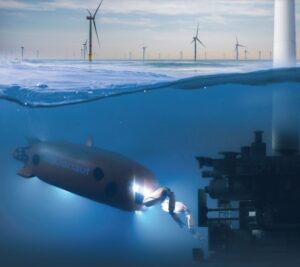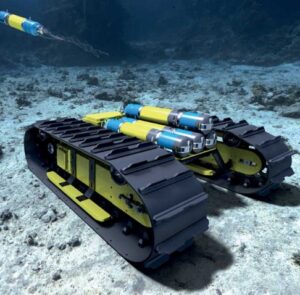The Defense Innovation Unit (DIU) recently awarded contracts to Nauticus Robotics [KITT] and
Greensea Systems to compete on prototypes to help the Marine Corps clear shallow water mines as they move from the sea to land.
DIU selected the two companies’ solutions from 67 total submissions as part of a competitive rapid prototyping effort. The two companies are expected to deliver prototype vehicles to the Marine Corps for evaluation by the fall of 2023, DIU said on Oct. 12.

DIU is working with Marine Corps Systems Command (MCSC), and the Office of the Deputy DoD CTO for Mission Capabilities on this program.
Greensea is partnering with subsidiary Bayonet Ocean Vehicles to deliver a prototype Bayonet-250 crawler based on a “mature commercial platform,” while Nauticus Robotics is working with VideoRay to design and build a ‘Terranaut’ concept vehicle with “the ability to crawl on the seafloor, and navigate through the water column using thrusters, the Defense Department said.
The announcement of these awards comes a week after Nauticus Robotics announced its part in the work as a second multi-million dollar contract with DIU to develop an amphibious unmanned system using the company’s ToolKITT autonomous command and control software platform.
The company noted it developed the ToolKITT autonomy platform via years of internal investments and advancements sponsored by government agencies and commercial customers. The software seeks to identify, classify and perform “complex underwater activities,” which it said can apply to removing, detecting, identifying, inspecting, and neutralizing underwater hazards.
Nauticus said ToolKITT was specifically designed to allow autonomous actions across multiple robot platforms and is already used in its Aquanaut product.
DoD plans for both prototypes to integrate with MCSC systems and stick to open architecture principles on interoperability.
DIU argued working with two prototype teams and their different technical approaches will provide the Marine Corps with operationality and risk reduction “while delivering the key features required to complete the mission.”
This effort is part of DIU’s Autonomous Amphibious Response Vehicle (A2RV) project that seeks to prototype unmanned amphibious systems able to detect, identify, localize, inspect and neutralize mines or “explosive hazards,” from very shallow water to the surf zone and beach exit.
DIU noted that while the Navy is responsible for finding and clearing mines at sea, the Marine Corps still requires its own capabilities to clear hazards in the surf and beach landing zone, as they move forces and material from ships to the shore.

A2RV specifically aims to provide Marine Corps commanders with several unmanned capabilities they can use to clear explosive hazards from various environments in the shallow waters and beach zones. These capabilities are meant to complement others and work together with other unmanned underwater vehicles, remote operated vehicles, unmanned surface vehicles, and Explosive Ordnance Disposal technicians as part of the larger Littoral Explosive Ordnance Neutralization (LEON) Program of Record.
According to the original DIU solicitation, A2RV seeks to help commanders detect, identify, inspect, and neutralize explosive hazards within in 40 feet of water or less through the beach exit. The solicitation said DIU planned to award one or more prototype OTAs to quickly adapt mature commercial technologies for the military, with a preferred prototyping period of 12 to 18 months that would last no longer than 24 months.
“During this time, DIU, in partnership with the U.S. Marine Corps, will characterize and evaluate the utility of the prototypes,” the notice said.
“DIU is excited for this partnership with Marine Corps Systems Command to provide these new capabilities to our Marines,” Maj. Alex Oliver, program manager at DIU, said in a statement.
“We are thrilled with the additional work the DIU and the U.S. Marine Corps have awarded us to continue providing leading maritime robotics and autonomy solutions to assist the warfighter,” said Ed Tovar, director of business development for defense systems at Nauticus, said in a statement.
While the Defense Department and Nauticus did not reveal the contract values, Oliver said IU receives additional funding from the Office of the Deputy CTO for Mission Capabilities (formerly the Rapid Reaction Technology Office), “which allows for multiple performers, ensuring maximum competition.”
Previously, in February Nauticus said it won an Other Transaction Agreement from DIU to prototype the ToolKITT aboard the Navy’s VideoRay Mission Specialist Defender Remotely Operated Vehicle for an undisclosed value.